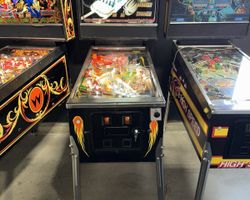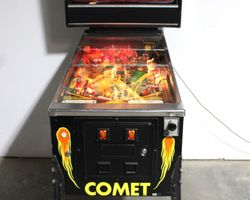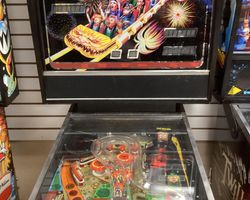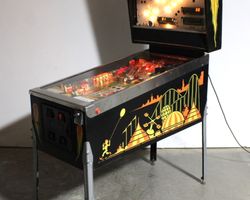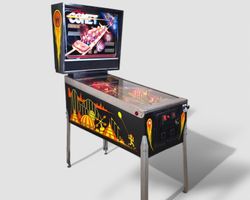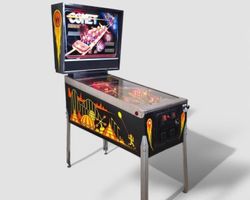Comet
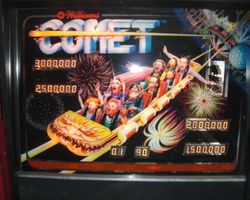
Average Prices: USD $200 to $1,400
Produced: June, 1985
Production Run: 8,100 units
Machine Type: Solid State Electronic
MPU: Williams System 9
Players: 4
Design by: Barry Oursler
Art by: Python Anghelo
Software by: Bill Pfutzenreuter
Comet, a pinball machine manufactured by Williams Electronic Games, Inc. in June 1985, transported players into a vibrant amusement park setting. Conceived by designer Barry Oursler, with artwork by Python Anghelo and software initially by Brian Dolatowski and later refined by Bill Pfutzenreuter, Comet emerged during a pivotal era for solid-state pinball. Its thematic inspiration stemmed from Chicago’s historic Riverview Amusement Park. Oursler originally considered naming the machine "Riverview" but shifted to "Comet," borrowing the name from one of the park’s roller coasters, ensuring broader recognition beyond the local Chicago area. This decision inadvertently established a thematic blueprint for Oursler, leading to a subsequent series of roller-coaster themed machines: Cyclone (1988) and Hurricane (1991).
The production run of 8,100 units underscored Williams’ confidence in the machine, which introduced a groundbreaking concept for solid-state pinball: the one million point shot. This high-value target redefined scoring expectations and provided a significant, thrilling objective for players. Python Anghelo, the artist, integrated a subtle nod to the impending 1986 near-Earth fly-by of Halley's Comet into the playfield, designing the top rollover inserts to spell "1-9-8-6." Comet was a System 9 machine, showcasing Williams' evolving technology of the mid-1980s, which included custom speech and digital displays.
Signature Features and Design
Comet’s design is a cohesive celebration of its amusement park theme, evident in both its mechanical features and visual artistry. Three distinct ramps anchor the playfield, creating dynamic shot opportunities that mimic the exhilaration of a carnival ride. The central Comet ramp serves as a primary scoring artery, while the upper-left Corkscrew Ramp and the upper-right Cycle Jump Ramp provide unique pathways and significant rewards.
Beyond the ramps, the "Dunk the Dummy" drop target stands out as an interactive toy, presenting a direct challenge that, when met, exposes a bull's-eye target for bonus multiplier progression. This mechanism adds a layer of timing and precision to the gameplay. Adjacent to this, the "Shooting Gallery" is represented by two banks of four standup targets each, depicting ducks and rabbits. Completing these banks is crucial for advancing game modes and lighting key features.
Python Anghelo’s artwork is a defining characteristic, imbuing the playfield with a whimsical, detailed, and often humorous aesthetic. The art captures the essence of a lively fairground, populated with caricatures and bustling scenes. The lighting scheme, while sometimes noted for its overall darkness in default settings, cleverly uses flashers and focused illumination to highlight active shots and indicate progress, particularly during the high-scoring sequences. The custom speech, including the distinctive "One Million!" callout by Steve Kordek, adds a personality to the machine, drawing players deeper into its carnival atmosphere.
Playfield and Mechanics
The playfield of Comet offers an open, intuitive layout that encourages fluid ball movement and accessible shots. At the top, the "1-9-8-6" rollover lanes serve as a skill shot opportunity and a gateway to the playfield multiplier, which can increase scores significantly for a limited duration. Players can use the right flipper button to strategically "lane change" these rollovers, aiming for the unlit numbers.
The lower playfield features two flippers, positioned to allow shots across the entire width of the game. Three pop bumpers, located centrally above the flippers, create chaotic yet score-boosting action, often propelling the ball into the lower portion of the playfield or back towards the flippers. Two kick-out holes—the "Funhouse" to the right of the Comet ramp and another associated with the Corkscrew ramp—provide momentary relief and often lead to new shot opportunities.
The main ramps are strategically placed: the Comet ramp, accessible from both flippers, is a central shot for progression. The Corkscrew ramp, tucked into the upper left, offers a challenging curving shot, while the Cycle Jump ramp on the upper right is the path to the machine’s most celebrated shot. Artwork across the playfield is consistently detailed, depicting roller coaster tracks, carnival tents, and amusing characters. The overall aesthetic is bright and inviting, reinforcing the lighthearted amusement park theme, even if the general illumination is somewhat subdued.
Gameplay Dynamics
Comet's gameplay revolves around a progression of objectives that culminate in its marquee feature: the one million point shot. The basic scoring mechanics are straightforward, with various targets and lanes awarding points. However, true high scores are achieved by understanding and executing the machine's distinct modes and strategic pathways.
The "1-9-8-6" rollover lanes are fundamental. Completing these not only scores 50,000 points but also activates a playfield multiplier (Red x2, x3, x5), crucial for amplifying subsequent scores. This multiplier is particularly significant on the fifth ball, where it reaches 5x, setting the stage for major scoring.
The "Dunk the Dummy" drop target, when hit, reveals a bull's-eye. Successfully hitting this bull's-eye progresses the bonus multiplier (Green: 2x, 3x, 4x, 5x), making end-of-ball bonuses substantially more rewarding. Meanwhile, the "Shooting Gallery" duck and rabbit target banks are vital for lighting the ramps. Completing both the duck and rabbit banks lights the central Comet ramp for higher point values, eventually leading to extra ball opportunities and Specials on subsequent successful shots. Similarly, completing these banks multiple times can also light the Corkscrew ramp for Specials or extra balls.
The pinnacle of Comet’s gameplay is the million-point shot. This objective is not always available from the start; it typically requires lighting the 1-9-8-6 rollovers and, critically, aligning with the 5x playfield multiplier on the last ball. Once these conditions are met, a precisely aimed shot up the Cycle Jump ramp, landing in its upper ring, unleashes the iconic "One Million!" voice callout and a dramatic light show, creating a memorable moment of triumph. This single shot introduced a new echelon of scoring, transforming the pursuit of high scores in pinball. While the game does not feature multiball, its layered objectives and the allure of the million-point shot provide sufficient depth and replayability.
Reception and Legacy
Comet garnered a largely positive reception within the pinball community, particularly for its accessibility and the exhilarating pursuit of its signature one million point shot. Its simplicity was often cited as a strength, making it welcoming for new players and a popular choice for family game rooms. Many pinball players recall Comet with fondness, associating it with their early experiences in the hobby. Its reliability and relative ease of maintenance also contributed to its enduring presence in arcades and home collections. The amusement park theme, paired with Python Anghelo’s detailed playfield artwork and fitting sound package—including the catchy music and the distinctive "ride the comet" screams and train horns—were frequently praised for creating an immersive atmosphere.
However, Comet was not without its criticisms. Some players found the gameplay could become repetitive, especially when compared to machines offering deeper rule sets or multiball modes, which Comet lacked. The general illumination was often described as being too dark, necessitating aftermarket modifications like LED upgrades for improved visibility. While the playfield art was generally admired, opinions on the side art and backglass were more mixed, with some finding them less appealing. Certain repetitive sound bites, like the "Hey Turkey, hit me!" callout, while initially memorable, could become grating over extended play sessions.
Despite these minor drawbacks, Comet’s legacy is robust. It holds a significant place in pinball history as the first solid-state machine to feature a one million point shot, a design innovation that directly influenced future scoring mechanics. It also initiated designer Barry Oursler’s notable series of roller-coaster themed games, directly preceding Cyclone and Hurricane, solidifying a thematic niche for Williams. Comet remains a sought-after machine for its nostalgic value, straightforward yet addictive gameplay, and its role as a precursor to more complex, event-driven pinball experiences. Its blend of accessible fun and a challenging high-score objective ensures its continued appreciation by enthusiasts.
Sponsored Links
 Ebay Listings
Ebay Listings
 Auction Results
Auction Results
| Cost | Location | Date |
|---|---|---|
| USD $4,599 |  California, United States California, United States |
13 November, 2025 |
| USD $1,600 |  Ohio, United States Ohio, United States |
26 April, 2025 |
| USD $1,600 |  Ohio, United States Ohio, United States |
26 April, 2025 |
| USD $1,950 |  Ohio, United States Ohio, United States |
29 March, 2025 |
| USD $1,600 |  Ohio, United States Ohio, United States |
16 November, 2024 |
| USD $1,100 |  Maryland, United States Maryland, United States |
10 October, 2024 |
| USD $2,150 |  Virginia, United States Virginia, United States |
25 February, 2024 |
| USD $1,026 |  Minnesota, United States Minnesota, United States |
18 December, 2023 |
| USD $3,000 |  California, United States California, United States |
07 December, 2023 |
| EUR €1,490 |  Nordrhein-Westfalen, Germany Nordrhein-Westfalen, Germany |
07 November, 2023 |


Private Policy · Search Website · Contact Us
As an eBay Partner, we may earn a commission from qualifying purchases made through links on this site, at no additional cost to you.
All trademarks and copyrighted materials remain property of their respective owners. All other content copyright 2007 - 2026 Pinpedia.

